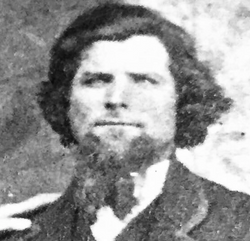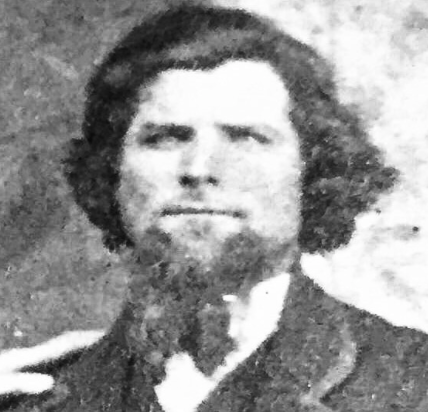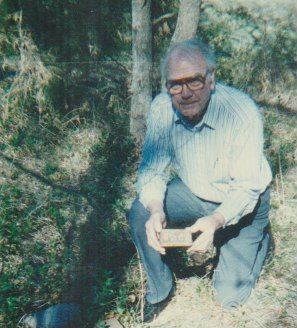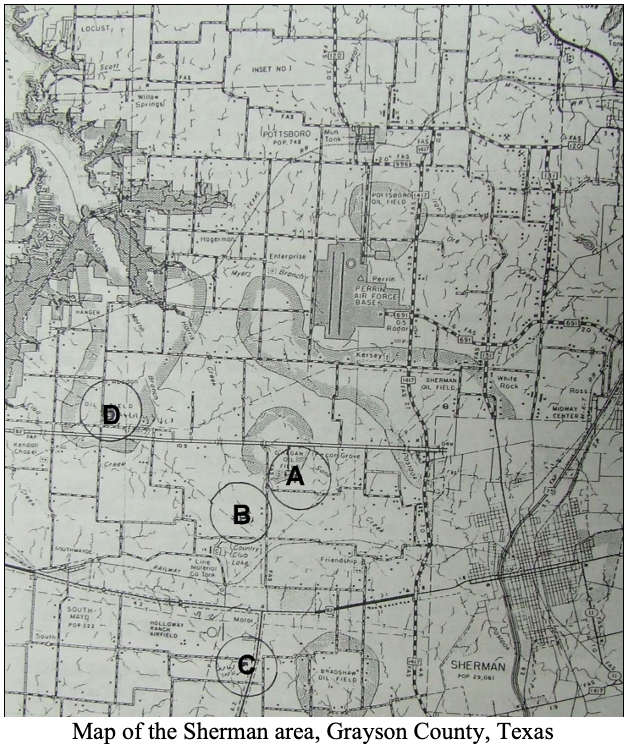According to what was told to Iris Shero Smith by her grandfather Christopher C. Shero, "William, Sr. chartered a boxcar to move the household goods and some livestock. The rest of the family rode on the train. One person only could ride on the boxcar so, Chris who was 17 rode on top to guard their possessions. While crossing Indian Territory (Okla.) the brakeman riding atop a boxcar was fired on." (No injuries) Dorothy DeWitt, granddaughter of William Leroy recalls being told that her family moved south in 1876 by covered wagon. Given that only two of the children of William and Christina were married as of the move, it is somewhat doubtful that the entire family (parents, single children) likely moved together.
During July 1866, Congress passed an act authorizing the Union Pacific to extend its southern branch (The Missouri-Kansas-Texas or MKT) from Kansas through Indian Territory to Ft. Smith, Arkansas and if they were ahead of other competing lines they could establish a line to Preston, Texas.
The MKT completed its survey for a roadbed across Oklahoma during 1870 following the 1870 Texas Road. Laying of the track began on the Cherokee border in June 1870. MKT trains were running to Muskogee by February 1871. Workers laid track across the Red River into Texas at Colbert's Ferry early in 1872. They laid l and ½ miles of track a day. A competing line 'Frisco' built a line from Saint Louis south through Neosha to Seneca on the SW Missouri border. In 1871 it crossed the Cherokee Nation to meet the MKT."
The family was duly recorded on 12 June 1880 as residing in Justice Precinct #1, Grayson County, Texas (Federal Census). Their long migration was finally over, having encompassed a trans-Atlantic voyage, and residencies in New York, Canada, Illinois, Iowa, and now Texas. William was now age 58, an active farmer and wife Christina was age 49. Two unmarried sons, Henry 18, and Charles 13 remained in the household. Their neighbor was young widow Maggie Wible. Christopher Shero age 21 was employed on her farm as a laborer and was getting better acquainted with his future wife, daughter Ada Myrtle Wible.
The enumerator, J. O. Nicholson, filled out the Agricultural Schedule during the same visit. William had 240 acres of land, 140 of which was unimproved. The farm was valued at $2000, farm implements at $500, livestock at $125. Farm products during 1879 totaled $350 in value (sold or consumed). Livestock as of June 1, 1880 included 6 horses, 3 milch cows, 4 other cows, 5 swine, 12 poultry (150 doz. eggs in 1879). No building repairs were made the previous year, no fertilizer was used and no hired labor was paid, 25 acres of Indian corn yielded 400 bushels, 10 acres of oats produced 100 bushels, 40 acres of wheat produced 465 bushels, and 8 acres of cotton produced 4 bales the previous year.
Again William Shero had considerable land and an impressive real estate value. Compared to his immediate neighbors he had more land yet over half of it was undeveloped. None of his land, like that of his neighbors was wooded. What is curious is the value of his acres. His land averages $8.33 per acre, far below that of adjoining farms. The average value was $16-$20 per acre. His immediate neighbor, Mrs. Wible, also had fairly poor land, valued at $10.00 per acre. William at the same time was equipment rich, with a higher ratio of value of farm implements to farm value. When compared to farm output his land (excluding unimproved and fallow land), was quite competitive with his neighbors with a per acre production of $3.50. Several nearby farms did worse, although others had a production value of $6-$8.00 and in two cases $19-$20,00 per acre!
See attached map of the Sherman area, Grayson County, Texas:
The label "A" denotes the location of the Wimberly Cemetery, the unmarked gravesite of William Shero. "B" marks the likely area that William farmed. "C" marks the Maggie Wible land, while "D" locates the Henry Shero land.
No land purchases by William Shero Sr. are on record until the spring of 1881 when he purchased the Harris Creek land that was described in the 1880 Agricultural Census. The instrument, dated and filed on April 15 recorded the purchase of 160 acres (20 more than indicated in the census) from J. W. Lankford for $610.00 six miles west and north of Sherman. The land was described as follows:
Beginning at southwest corner John Hendrix survey of 320 acres a post from which a small elm marked X bears South 7.5 degrees 185 2/3 vrs. Thence N with Hendrix West line 950 vrs. To his Northwest corner and J. Coffer's South West Corner, continuing with said Coffer's West line in all 1344 vrs. to a stake. Thence West 672 vrs. to a stake from which an elm marked X bears north 78 deg. West 12 vrs. Thence South 1344 vrs. to a stake and mound. Thence East 672 vrs. to the place of beginning. Said land being the land patented to John K. Miller on the 19th day Nov., 1861.
A promissory note with a due date of April 15, 1882 was also part of the transaction.
William Shero died while helping to fight a fire on the Wimberly meadow at 5 a.m. on October 5, 1882. He was buried in the Wimberly Cemetery, a private burial ground. His grave is unmarked but its location is known. It had a sandstone marker at one time, but it is now gone. H. M. Patty was appointed administrator of the estate, with bond of $4000 on the 30th of October. Estate appraisers J. M. Meems, Joseph F. Doggy, and William Walsh were selected by the county court. The inventory which does not survive in the probate records, was filed and approved on January 4, 1883. This allowed the administrator to sell the farm, which he did, curiously back to Mr. Lankford, for $6.00 per acre for a total of $960. This sale was filed on February 24th following court review and approval. The final report was filed April 7, 1885.
W.H. Lankford had filed a claim against the estate for $785.07, apparently an unpaid promissory note from the original land purchase with a due date of September 15, three weeks prior to William's death. The claim was filed November 28, approved December 9, and included a 12% interest rate. The resale of the land to Lankford covered this debt.
Christina Shero, widowed, would live another 32 years. She is apparently not yet located in the 1900 Federal Census. At the time of her death on January 1, 1914, she was living with her son Charles Shero on Travis Street in Sherman. The widow of Earl Shero, told Iris Shero Smith that Christina lived with her son Christopher and family until Chris moved his family to Oklahoma in 1911. An obituary, written for the local paper, partly survives in the family Bible:
"Christena Burr Shero died in her 85th year and was born in Alsas, Loraine Germany in Oct 1831. She was an infant when her parents came to New York. She has one daughter Mrs. Christen Ritchie and six sons survive her. The names William, Philip, Louis, Isaac, Chris, and Charles. She was baptized by Elder W. C. Dimmit 29 years ago. Had lived a Lutheran."
Christina sold two tracts of land to son Henry on November 25, 1897 for $850. These were 40 acres in the Pearson Survey on Big Mineral Bayou, and 9/10ths interest in 50 additional acres in that same survey, all in Plainview Precinct. She received two payments of $325. paid on November 24, 1898 and the same date, 1899 and $200 paid January 8, 1901. No record of purchase for this land on her part has been located. No probate record has been located. She is buried at West Hill Cemetery in Sherman.
According to what was told to Iris Shero Smith by her grandfather Christopher C. Shero, "William, Sr. chartered a boxcar to move the household goods and some livestock. The rest of the family rode on the train. One person only could ride on the boxcar so, Chris who was 17 rode on top to guard their possessions. While crossing Indian Territory (Okla.) the brakeman riding atop a boxcar was fired on." (No injuries) Dorothy DeWitt, granddaughter of William Leroy recalls being told that her family moved south in 1876 by covered wagon. Given that only two of the children of William and Christina were married as of the move, it is somewhat doubtful that the entire family (parents, single children) likely moved together.
During July 1866, Congress passed an act authorizing the Union Pacific to extend its southern branch (The Missouri-Kansas-Texas or MKT) from Kansas through Indian Territory to Ft. Smith, Arkansas and if they were ahead of other competing lines they could establish a line to Preston, Texas.
The MKT completed its survey for a roadbed across Oklahoma during 1870 following the 1870 Texas Road. Laying of the track began on the Cherokee border in June 1870. MKT trains were running to Muskogee by February 1871. Workers laid track across the Red River into Texas at Colbert's Ferry early in 1872. They laid l and ½ miles of track a day. A competing line 'Frisco' built a line from Saint Louis south through Neosha to Seneca on the SW Missouri border. In 1871 it crossed the Cherokee Nation to meet the MKT."
The family was duly recorded on 12 June 1880 as residing in Justice Precinct #1, Grayson County, Texas (Federal Census). Their long migration was finally over, having encompassed a trans-Atlantic voyage, and residencies in New York, Canada, Illinois, Iowa, and now Texas. William was now age 58, an active farmer and wife Christina was age 49. Two unmarried sons, Henry 18, and Charles 13 remained in the household. Their neighbor was young widow Maggie Wible. Christopher Shero age 21 was employed on her farm as a laborer and was getting better acquainted with his future wife, daughter Ada Myrtle Wible.
The enumerator, J. O. Nicholson, filled out the Agricultural Schedule during the same visit. William had 240 acres of land, 140 of which was unimproved. The farm was valued at $2000, farm implements at $500, livestock at $125. Farm products during 1879 totaled $350 in value (sold or consumed). Livestock as of June 1, 1880 included 6 horses, 3 milch cows, 4 other cows, 5 swine, 12 poultry (150 doz. eggs in 1879). No building repairs were made the previous year, no fertilizer was used and no hired labor was paid, 25 acres of Indian corn yielded 400 bushels, 10 acres of oats produced 100 bushels, 40 acres of wheat produced 465 bushels, and 8 acres of cotton produced 4 bales the previous year.
Again William Shero had considerable land and an impressive real estate value. Compared to his immediate neighbors he had more land yet over half of it was undeveloped. None of his land, like that of his neighbors was wooded. What is curious is the value of his acres. His land averages $8.33 per acre, far below that of adjoining farms. The average value was $16-$20 per acre. His immediate neighbor, Mrs. Wible, also had fairly poor land, valued at $10.00 per acre. William at the same time was equipment rich, with a higher ratio of value of farm implements to farm value. When compared to farm output his land (excluding unimproved and fallow land), was quite competitive with his neighbors with a per acre production of $3.50. Several nearby farms did worse, although others had a production value of $6-$8.00 and in two cases $19-$20,00 per acre!
See attached map of the Sherman area, Grayson County, Texas:
The label "A" denotes the location of the Wimberly Cemetery, the unmarked gravesite of William Shero. "B" marks the likely area that William farmed. "C" marks the Maggie Wible land, while "D" locates the Henry Shero land.
No land purchases by William Shero Sr. are on record until the spring of 1881 when he purchased the Harris Creek land that was described in the 1880 Agricultural Census. The instrument, dated and filed on April 15 recorded the purchase of 160 acres (20 more than indicated in the census) from J. W. Lankford for $610.00 six miles west and north of Sherman. The land was described as follows:
Beginning at southwest corner John Hendrix survey of 320 acres a post from which a small elm marked X bears South 7.5 degrees 185 2/3 vrs. Thence N with Hendrix West line 950 vrs. To his Northwest corner and J. Coffer's South West Corner, continuing with said Coffer's West line in all 1344 vrs. to a stake. Thence West 672 vrs. to a stake from which an elm marked X bears north 78 deg. West 12 vrs. Thence South 1344 vrs. to a stake and mound. Thence East 672 vrs. to the place of beginning. Said land being the land patented to John K. Miller on the 19th day Nov., 1861.
A promissory note with a due date of April 15, 1882 was also part of the transaction.
William Shero died while helping to fight a fire on the Wimberly meadow at 5 a.m. on October 5, 1882. He was buried in the Wimberly Cemetery, a private burial ground. His grave is unmarked but its location is known. It had a sandstone marker at one time, but it is now gone. H. M. Patty was appointed administrator of the estate, with bond of $4000 on the 30th of October. Estate appraisers J. M. Meems, Joseph F. Doggy, and William Walsh were selected by the county court. The inventory which does not survive in the probate records, was filed and approved on January 4, 1883. This allowed the administrator to sell the farm, which he did, curiously back to Mr. Lankford, for $6.00 per acre for a total of $960. This sale was filed on February 24th following court review and approval. The final report was filed April 7, 1885.
W.H. Lankford had filed a claim against the estate for $785.07, apparently an unpaid promissory note from the original land purchase with a due date of September 15, three weeks prior to William's death. The claim was filed November 28, approved December 9, and included a 12% interest rate. The resale of the land to Lankford covered this debt.
Christina Shero, widowed, would live another 32 years. She is apparently not yet located in the 1900 Federal Census. At the time of her death on January 1, 1914, she was living with her son Charles Shero on Travis Street in Sherman. The widow of Earl Shero, told Iris Shero Smith that Christina lived with her son Christopher and family until Chris moved his family to Oklahoma in 1911. An obituary, written for the local paper, partly survives in the family Bible:
"Christena Burr Shero died in her 85th year and was born in Alsas, Loraine Germany in Oct 1831. She was an infant when her parents came to New York. She has one daughter Mrs. Christen Ritchie and six sons survive her. The names William, Philip, Louis, Isaac, Chris, and Charles. She was baptized by Elder W. C. Dimmit 29 years ago. Had lived a Lutheran."
Christina sold two tracts of land to son Henry on November 25, 1897 for $850. These were 40 acres in the Pearson Survey on Big Mineral Bayou, and 9/10ths interest in 50 additional acres in that same survey, all in Plainview Precinct. She received two payments of $325. paid on November 24, 1898 and the same date, 1899 and $200 paid January 8, 1901. No record of purchase for this land on her part has been located. No probate record has been located. She is buried at West Hill Cemetery in Sherman.
Family Members
Advertisement
Explore more
Sponsored by Ancestry
Advertisement















